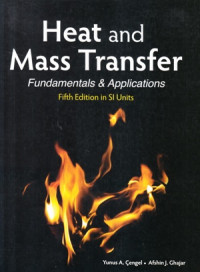Text
Heat and mass transfer : fundamentals and applications
BACKGROUND
Heat and mass transfer is a basic science that deals with the rate of transfer of thermal energy. It has a broad application area ranging from biological systems to common household appliances, residential and commercial buildings, industrial processes, electronic devices, and food processing. Students are assumed to have an adequate background in calcu¬lus and physics. The completion of first courses in thermodynamics, fluid mechanics, and differential equations prior to taking heat transfer is desirable. However, relevant concepts from these topics are introduced and reviewed as needed.
OBJECTIVES
This book is intended for undergraduate engineering students in their sopho-more or junior year, and as a reference book for practicing engineers. The objectives of this text are
1. To cover the basic principles of heat transfer.
2. To present a wealth of real-world engineering examples to give students
a feel for how heat transfer is applied in engineering practice.
3. To develop an intuitive understanding of heat transfer by emphasizing
the physics and physical arguments.
It is our hope that this book, through its careful explanations of concepts and its use of numerous practical examples and figures, helps the students develop the necessary skills to bridge the gap between knowledge and the confidence for proper application of that knowledge.
In engineering practice, an understanding of the mechanisms of heat transfer is becoming increasingly important since heat transfer plays a crucial role in the design of vehicles, power plants, refrigerators, electronic devices, build¬ings, and bridges, among other things. Even a chef needs to have an intui¬tive understanding pf the heat transfer mechanism in order to cook the food "right" by adjusting the rate of heat transfer. We may not be aware of it, but we already use the principles of heat transfer when seeking thermal comfort. We insulate our bodies by putting on heavy coats in winter, and we minimize heat gain by radiation by staying in shady places in summer. We speed up the cool-ing of hot food by blowing on it and keep warm in cold weather by cuddling up and thus minimizing the exposed surface area. That is, we already use heat transfer whether we realize it or not.
Ketersediaan
Informasi Detail
- Judul Seri
-
-
- No. Panggil
-
536.2 Cen h
- Penerbit
- New York : Mc Graw-Hill., 2015
- Deskripsi Fisik
-
xxiv, 946 hal. : il. ; 25 cm.
- Bahasa
-
English
- ISBN/ISSN
-
9789814595278
- Klasifikasi
-
536.2
- Tipe Isi
-
-
- Tipe Media
-
-
- Tipe Pembawa
-
-
- Edisi
-
Ed. V
- Subjek
- Info Detail Spesifik
-
-
- Pernyataan Tanggungjawab
-
-
Versi lain/terkait
Tidak tersedia versi lain
Lampiran Berkas
Komentar
Anda harus masuk sebelum memberikan komentar

 Karya Umum
Karya Umum  Filsafat
Filsafat  Agama
Agama  Ilmu-ilmu Sosial
Ilmu-ilmu Sosial  Bahasa
Bahasa  Ilmu-ilmu Murni
Ilmu-ilmu Murni  Ilmu-ilmu Terapan
Ilmu-ilmu Terapan  Kesenian, Hiburan, dan Olahraga
Kesenian, Hiburan, dan Olahraga  Kesusastraan
Kesusastraan  Geografi dan Sejarah
Geografi dan Sejarah